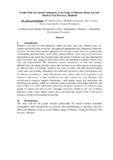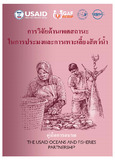| dc.identifier.citation | Sornkliang, J., Tiaye, R., Yenpoeng, T., Kaewtankam , V., & Pholcharoen , J. (2017). Gender Role in Coastal Community: Case Study at Mairoot, Klong Yai Sub-districts Trat Province, Thailand . SEAFDEC Technical Seminar 2017 (pp. 11-14). Samut Prakan: Training Department, Southeast Asian Fisheries Development Center. | en |
| dc.description | Gender is one form of social difference (others are: class, caste, age, ethnicity, race, etc). Gender specifically refers to society’s perception of appropriate roles, obligations, behaviors, activities, and status that considers appropriate for men and women, based on existing norms of femininity and masculinity. Gender Roles, Responsibilities, Time and Lived Experiences Information on the norms that influenced men and women’s behavior, and also structures the type of activities they engage in, their social status, the importance assigned to their work, roles and responsibilities. This dimension captures information on men and women’s different roles, the timing and place where their activities occur, their capacity to participate in different types of economic, political and social activities, and their decision-making. (Time, space and mobility, Household and community division of labor, Participation rates in different activities,and Roles). This domain also explores their lived experiences and emotional dimensions of their livelihoods and their reproductive lives. Working with environmental resources requires relationship with people, nature and institutions, the challenges they possess, which are sometimes uneasy, uncertain, and fraught with stress and anxiety. This is to collect information about the emotional experiences of different social groups of women and men (e.g. loss, nostalgia, insecurity, defiant in the face of threat, protective, stress, worry, shame, shock, and so on) when they recall or refer to the use of resources and the power relations around this. | en |



